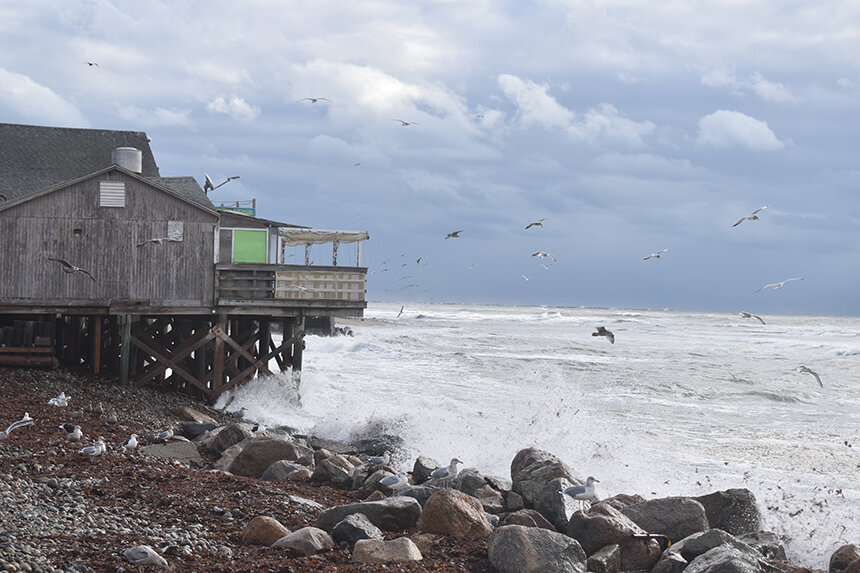NARRAGANSETT, R.I. — The water breached the seawall. Foaming waves sloshed over the concrete strip, a place where, on a nice day, people sit and watch the sunset or shoot the breeze about local happenings.
The waves continued their run and flooded the nearby intersection, only stopping when they spilled into Little Neck Pond across the street, which gorged itself on seawater. When it was over, much of the pride of Narragansett — its town beach — was gone.
“During Sandy, the water came up over the wall and onto the road. It was crazy … we lost a ton of sand that year,” said Kaitlyn Murray, who grew up spending summers sitting in the shade of Chair 6 on Narragansett Town Beach.
In fall 2012 Superstorm Sandy stripped some 1,600 tons of sand from the crown jewel of Narragansett’s beaches.
But the coastal community bounced back. The Coast Guard House Restaurant, an Ocean Road institution that lost a chunk of its structure to the superstorm, was rebuilt, and by the following summer, most of the sand was back on Narragansett Town Beach.
All of this restoration work came with a hefty price tag. To restore the popular beach, trucks delivered some 6,000 cubic yards of sand to replace the washed-away beach. In total, to deal with erosion caused by that one storm, the town paid $167,720 for beach sand, $42,000 for dune sand and $40,000 for beachgrass.
“There was a lot they had to redo, and they got it all done for the summer, which was crazy,” said Murray, 29. “I remember them bringing in truckloads of sand to try to get the beach ready.”
While much of the devastation Sandy wrought was remedied in the short term, Narragansett, like Rhode Island’s 20 other coastal municipalities, has a reckoning heading its way.
When Murray was young, she and her friends would walk from the North Pavilion down toward the seawall. There, they would clamber up on the boulders that had tumbled from the wall’s side, and peer into tide pools with the hopes of finding a hermit crab or other sea critters.
“Me and my mom and dad or my friends would go and walk out onto the rocks, and you could pretty much walk to the Coast Guard House,” she said, pointing to where the rocks are now underwater. “The water would eventually come up to where those rocks are dark now, but you could easily walk through there.”
The slice of beach near the rocks that Murray climbed as a kid has also shrunken over the years, and only tourists who don’t know better bring their beach umbrellas down this way.
“This would be white, dry sand up here just like it is at the other end,” Murray said. “It’s so strange that the water comes all the way up to the wall now.”
According to the Coastal Resources Management Council’s Beach SAMP Coastal Environmental Risk Index maps, in the event of a 100-year storm, combined with 3 feet of sea-level rise, much of the southern portion of Narragansett Town Beach, as well as Narragansett Pier, are at extreme risk. Some areas are even marked in the “inundated by 2100” category.
Narragansett’s coastline, like that of the Ocean State, is changing, but the question remains if anything can or will be done.
“This is our bread and butter. And if Mother Nature’s pushing us back, we’re going to lose that bread and butter,” said Kevin Durfee, owner of George’s of Galilee in Point Judith, a popular Narragansett fishing village on the western side of Narragansett Bay.
Durfee has seen the changes over the years, from witnessing the nearby hard-hit Matunuck area to the daily challenges of running a restaurant that abuts Salty Brine State Beach.
“The oceans are encroaching,” Durfee said during an interview in mid-October of last year. “Our tiki area was destroyed two weeks ago. We had a windstorm and the water had come right up to the bar, undermined the sand underneath it and the whole dining area was just trashed. Everything just got pushed aside, almost washed back out to sea.”
In the winter, the waves will break and come halfway up the parking lot behind the restaurant, and with bigger storms the water comes right up to the building.
“We have the breakwall out there, and if it wasn’t for that breakwall, I'm sure this place wouldn’t be here,” Durfee said.
But even with the challenges that come year to year, change is a hard thing for a town that relies on tourists and its beaches for a good chunk of its income, according to Murray and Durfee.
“Narragansett is, in its bones, a beach town,” Murray said. “The Coast Guard House, George’s, all of them rely on tourism. I’m on a Narragansett ‘Our Town’ page on Facebook and people are always talking about how this community thrives on tourism, and how we need to stop complaining about tourists because it’s what makes us a viable town.”
Durfee believes the town should consider making changes to the areas surrounding Narragansett Town Beach in an effort to think long term.
“I have a different opinion than most in Narragansett of what they should do to that beach,” he said. “They should probably take that south lot and rip it out and put sand in there and then dunes that go right to the road, and people should park farther away — because Mother Nature is definitely pushing forward — and if we just keep putting sand on the beach every time, it’s just putting more good money into bad solutions.”









